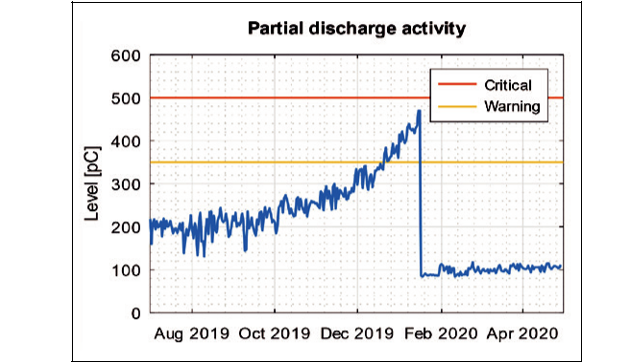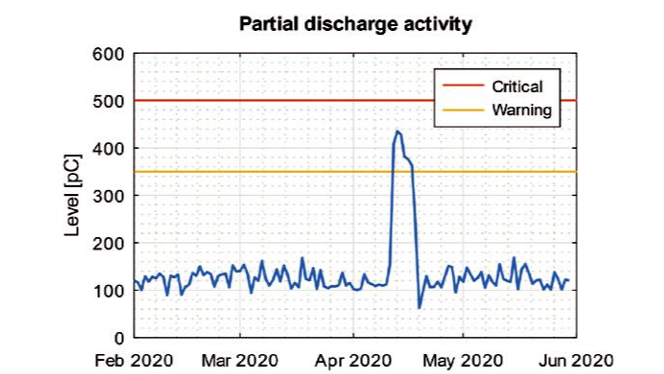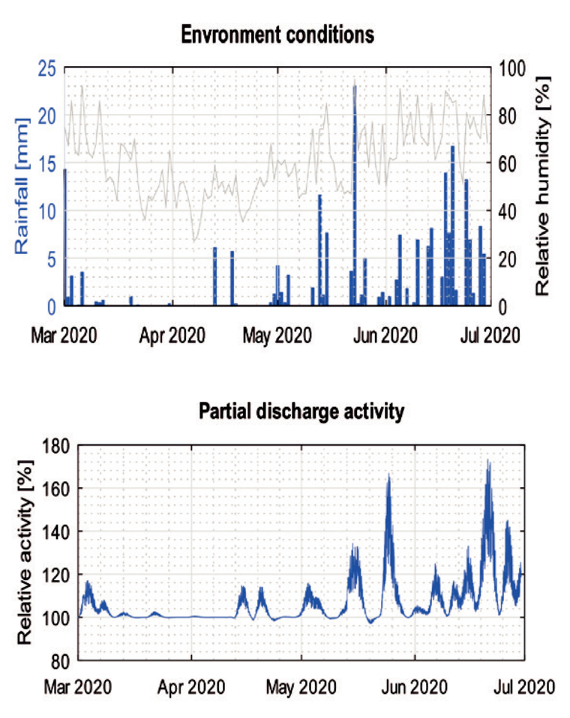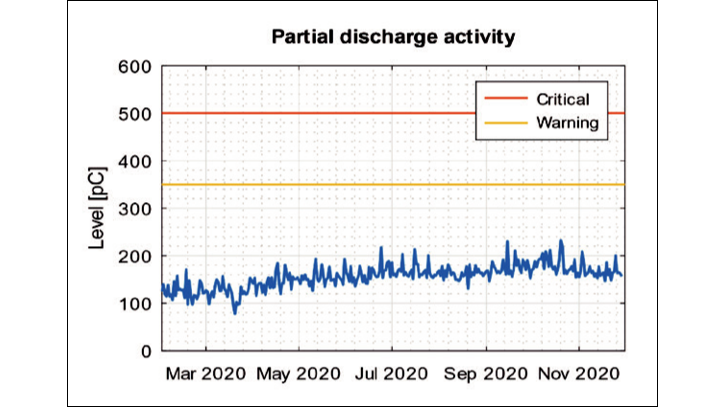Results and Operational Experience of Partial Discharge Monitoring
Dozens of PD Doctor installations across Europe have proven their high added user value and reliability for customers. They have detected degradation of existing lines, helped eliminate high interference on overhead lines, established the link between rainy weather and increasing partial discharge (PD) activity, for example, or helped save significant amounts of money by postponing originally planned power line replacements.
Case 1 – Line degradation and replacement
Long-term monitoring at the customer’s utility has shown that the magnitude of partial discharges in the equipment in its substation is approaching a critical level. Using the PD Doctor system, the customer was able to plan an emergency outage in time to replace the problematic section of line.
Under normal circumstances (i.e. without the presence of ModemTec’s permanent PD Doctor system diagnostics), the fault would most likely proceed in the usual way: partial discharges would lead to a complete loss of the insulation state and thus to a breakdown.
The consequences in this case could be very unpleasant for the customer, ranging from an unplanned interruption of the power supply, to a subsequent fire, to a possible threat to the lives of nearby persons.

Case 1: Line degradation and replacement
Case 2 – Interference on the line (damaged HV compensation)

(damaged HV compensation)
Unexpectedly, a spike in partial discharge activity was registered at the PD Doctor installation site. Since the PDs increase continuously (this is due to their physical principle – slow degradation of insulation), this situation was very unusual.
In this case, the occurrence of the step change was detected by the fact that one of the customers of the EE distributor had connected equipment to the power network that did not fully comply with the applicable standards and exhibited faulty behaviour.
Such a high level of interference and the latent PDs within it have resulted in other customers facing significant difficulties in operating their equipment fed from this affected line.
The sharp increase in the level of PD with its unique and characteristic pattern meant that the customer’s equipment did not comply with the EMC requirements).
As a result, EE’s distributor intervened and discovered that an anomaly (in this case, damage to the HV compensation) had indeed occurred at one of the customers’ premises and, following their notification, repairs were made to this equipment. This then subsequently resulted in a step reduction in the level of HV to the normal level recorded prior to the incident.
It was thus clearly confirmed that the obtained trends exemplarily represent the strength of continuous (online) measurements via the PD Doctor system and at the same time the great weakness and shortcoming of the standard offline measurements applied so far.
In the case of a single measurement, performed once a year, its result (and therefore presentation) would be strongly influenced by the day on which the measurement was performed, and furthermore, it would not be able to warn the user in time of anomalies (often with fatal consequences) that may occur in the interim period when the measurement is not performed.
Case 3 – Rain and increasing PD activity
It is not surprising that the surrounding environment can greatly affect the reliability of results in offline diagnostics. When the relative humidity is elevated (e.g. after rain), corona-type surface discharges significantly increase the incidence of partial discharges that standard offline measurements used to date are unable to detect.
It was therefore a great surprise to the customer when the PD Doctor system linked the records of rain activity times in the monitored section of the cable line with the records of partial discharges when online diagnostics were deployed. From the analysis of the discharges, it was found that these were not corona discharges at the outdoor facilities, but internal discharges in the actual cable being monitored.
Long-term monitoring has thus demonstrated this dependency. The use of PD Doctor on-line diagnostics eliminates the disadvantage of applying standard offline diagnostics, which often produces a distorted picture until almost the beginning of the fault condition. Similarly, the advantage of PD Doctor online diagnostics over standard offline diagnostics could be characterised for adverse conditions such as ice or snow.

Case 4 – Postponement of line replacement

One of the major foreign energy entities planned to replace a part of the line based on the principle of time-based maintenance (TBM). However, after deploying the PD Doctor system, it found that the original cables and connectors were in good condition from a safety point of view, and by postponing this investment it saved several thousand euros.
The permanent deployment of the PD Doctor diagnostic equipment enables continuous monitoring of the technical condition of electrical equipment and lines, their reliability and safety. Planning the renewal of, for example, cable lines is usually based on a statistical (i.e. mathematically modelled) estimate of the technical lifetime of the equipment. Continuous monitoring thus allows maximising the use of technical assets, right up to the limit of their physical lifetime.
In addition to this advantage, the permanent installation of ModemTec’s diagnostic tool is able to ensure the safety of the operation of power equipment.
